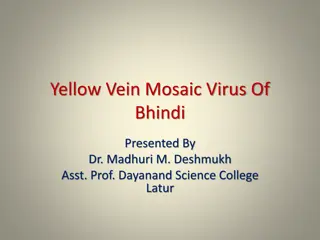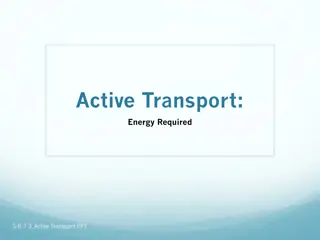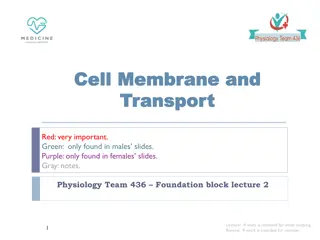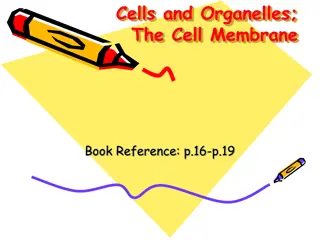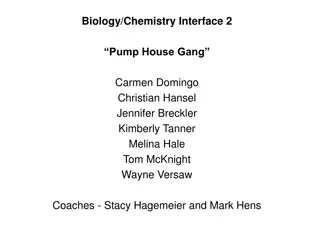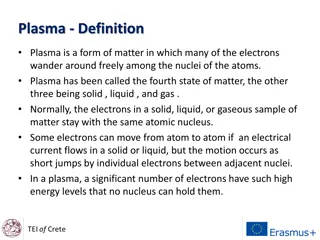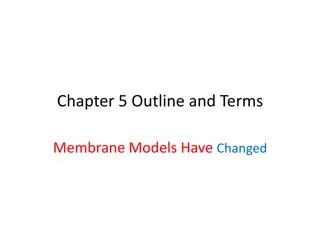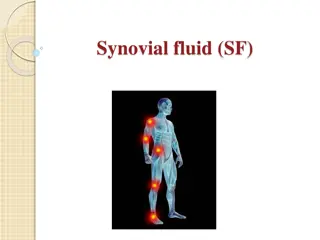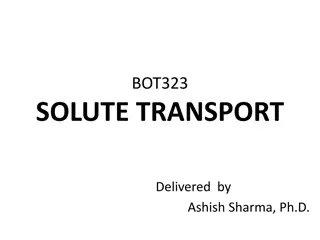Understanding the Fluid Mosaic Model of Plasma Membrane Structure
The fluid mosaic model proposed by S.J. Singer and Garth L. Nicolson describes the structure of the plasma membrane as a fluid combination of phospholipids, cholesterol, proteins, and carbohydrates. This model explains how phospholipids form a stable barrier, the role of saturated and unsaturated fatty acids in membrane fluidity, the presence of lipid rafts, and the types of proteins found in the membrane. Factors affecting membrane fluidity, such as temperature and cholesterol, are also discussed.
Download Presentation

Please find below an Image/Link to download the presentation.
The content on the website is provided AS IS for your information and personal use only. It may not be sold, licensed, or shared on other websites without obtaining consent from the author. Download presentation by click this link. If you encounter any issues during the download, it is possible that the publisher has removed the file from their server.
E N D
Presentation Transcript
Plasma membrane S.J. Singer and Garth L. Nicolson proposed the fluid mosaic model , which is widely used. The fluid mosaic model of the plasma membrane structure describes the plasma membrane as a fluid combination of phospholipids, cholesterol, proteins, and carbohydrates.
The fluid mosaic model was proposed by S.J. Singer and Garth L. Nicolson. This model explains the structure of the plasma membrane of animal cells as a mosaic of components such as phospholipids, proteins, cholesterol, and carbohydrates. These components give a fluid character to the membranes The fundamental building blocks of all cell membranes are phospholipids. Amphipathic molecules, two hydrophobic fatty acid chains linked to a phosphate-containing hydrophilic head group phospholipid bilayers form a stable barrier between two aqueous compartments and represent the basic structure of all biological membranes.
Saturated and Unsaturated Fatty Acids Fatty acids make up the phospholipid tails. Saturated fatty acid chains have a single bond between the carbon atoms whereas, unsaturated fatty acid chains have double bonds between the carbon atoms. Double bonds make it harder for the chain to pack tightly by creating kinks. These kinks increase the fluidity of the membrane. Also Read: Lipids Restriction to Fluidity of Plasma Membrane Lipid Rafts These are the lipid domains found on the external leaflet of the plasma membrane. Cholesterol, glycosphingolipids, glycosylphosphatidylinositol are the building blocks of lipid rafts. Protein Complexes Proteins and glycoproteins are diffused within the plasma membrane. These help in the transport of ions and metabolites, cell signalling, adhesion, and migration. Key Points on Fluid Mosaic Model The plasma membrane comprises amphiphilic, phospholipid molecules. The second important component of the plasma membrane is integral proteins that are integrated completely into the membrane. Carbohydrates are found on the external surface of the membrane where they are bound to proteins or lipids.
Phospholipids Phospholipids are amphipathic molecules with a hydrophilic head and a hydrophobic tail. These are attached to a glycerol molecule by a covalent bond. Cholesterol It helps the plasma membrane to retain the fluidity. It is present between the phospholipids and prevents the compaction of hydrophilic tails at low temperatures and their expansion at high temperatures. Proteins The plasma membrane has three types of proteins: Integral Proteins: These proteins form channels to allow the movement of large molecules and ions across the hydrophobic layer of the membrane. Peripheral Proteins: These are found embedded in a single leaflet of the membrane. They carry signals from one segment of the membrane and relay it to the another. Glycoproteins: They stabilize the membrane and are responsible for intercellular communication. Factors Affecting Fluidity of Plasma Membrane The fluidity of the cell membrane is influenced by three factors: Temperature Phospholipids are found close together when it is cold. When it s hot, they move apart. Cholesterol The cholesterol molecules are randomly distributed along the phospholipid bilayer and hold it preventing it from separating too far, or compact too tightly.
The fluidity of the plasma membrane is affected by: Length of the fatty acid tail Temperature Cholesterol Degree of saturation of fatty acid tails



